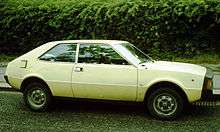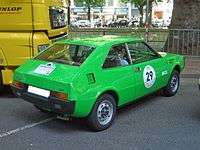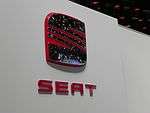SEAT 1200 Sport
The SEAT 1200 Sport is a two-door, four-seater coupé presented officially by SEAT in December 1975 and sold commercially from February 1976 to September 1979.[1] It was the first model for the Spanish brand entirely developed in its newly opened Martorell Technical Centre, and was thus immensely important for SEAT. When launched it was powered by the bigger 1,197 cc engine of 67 PS (49 kW) carried from the SEAT 124, which in this application was transversely mounted and canted forwards by 16°. This engine through a four-speed gearbox transmission gave the little 2+2 a top speed of 157 km/h (98 mph). Despite its sporting aspirations, power output was limited by a relatively low compression ratio, reflecting the fuel octane levels available on its home market.[2]
| SEAT 1200/1430 Sport | |
|---|---|
 SEAT 1200 Sport | |
| Overview | |
| Manufacturer | SEAT |
| Also called | SEAT 1200/1430 Sport 'Bocanegra' |
| Production | 1975-1981 |
| Assembly | Spain |
| Designer | Aldo Sessano |
| Powertrain | |
| Engine | 1,197 cc (1200 Sport) 1,438 cc (1430 Sport) |
| Transmission | 4-speed manual |
| Dimensions | |
| Wheelbase | 2,225 mm (87.6 in) |
| Length | 3,665 mm (144.3 in) |
| Width | 1,555 mm (61.2 in) |
| Height | 1,250 mm (49 in) |
| Curb weight | 805–815 kg (1,775–1,797 lb) |
| Chronology | |
| Successor | SEAT Bocanegra concept car |
The sharp-edged body design had a drag coefficient (cd) of 0.37 and was purchased from NSU of Germany, after the German firm had abandoned its plans to launch its own small car, the based on the NSU Prinz rear-engined NSU Nergal model, presented as a prototype in the 1970 Turin Motor Show and designed by the Italian designer Aldo Sessano.[3][4] It was Antoni Amat, the technical director of Inducar (Industrias de la Carrocería) i.e. an external provider for SEAT, the man who conceived the idea of proposing the whole project to SEAT with the mediation of Günter Óistrach, after the former's visit and contacts at the Turin Motor Show,[5] with the Terrassa-based Inducar company undertaking from SEAT the production of the chassis for its SEAT 1200 Sport car.[6] The purchased rights Nergal design had been sublimed to modifications in a mixture of elements with another Sessano's concept car i.e. the OTAS KL112, in order to fit in with the underpinnings meant to be used by SEAT, as it was based upon the ones of a Fiat 127. However the remainings of the original NSU Nergal design were still present in the SEAT production model: the air-vents in the third pillar just above the rear wheel arch were likely indicating the presence of the rear-mounted engine in NSU's donor design. In fact though SEAT's engineers first examined the possibility to keep the rear-engine layout in the SEAT 1200 Sport, they made the final choice in favor of a front-engined one. Its boot featured a remote opening through a handle on to driver's door[7] and had a capacity of 339 litres.[7]
In 1977, the SEAT 1430 Sport Coupé was introduced, using the same body, but with a retuned version of the engine from the SEAT 1430. In this application, the 1,438-cc engine provided a power output of 77 PS (57 kW) and a top speed of 164 km/h (102 mph).
The Sport versions were offered mainly in the Spanish market, but also some cars were officially offered in other European countries such as Germany, Holland, Belgium, and France. Both models, 1200 and 1430, were discontinued in 1979, along with the SEAT 128, SEAT 133, and CKD-built Lancia Beta and Beta HPE, as part of the important restructuring of the SEAT range for 1980. A total of 19,332 units was sold in the Spanish market, with 11,619 cars being equipped with the 1200 engine and some 7,713 units with the more powerful but late-launched 1430 motor.[8]
The car was widely known as the "Boca negra" ("black mouth" in Spanish) because of the color and shape of its always black plastic front panel, which embraced the front grille and the headlights and incorporated, by 1970s standards, a prominent front bumper. In 2008, SEAT presented the SEAT Bocanegra concept car at the Geneva Motor Show. It received this name as a homage to the classic 1200 Sport, as it also had a black front end. It is sold as a special-edition Ibiza model from the second half of 2009, based on the SEAT Ibiza FR and Cupra versions.
 SEAT 1200 Sport, side view
SEAT 1200 Sport, side view SEAT 1200 Sport, rear view
SEAT 1200 Sport, rear view SEAT 1430 Sport
SEAT 1430 Sport
| SEAT | 1200 Sport | 1430 Sport |
|---|---|---|
| Engine: | 4-cylinder-inline engine (four-stroke), transversely front-mounted | |
| Displacement: | 1,197 cc | 1,438 cc |
| Bore x Stroke: | 73 x 71.5 mm | 80 x 71.5 mm |
| Max. Power @ rpm: | 67 PS (49 kW) @ 5,600 | 77 PS (57 kW) @ 5,400 |
| Max. Torque @ rpm: | 90 N⋅m (66 lb⋅ft) @ 3,700 | 111 N⋅m (82 lb⋅ft) @ 3,400 |
| Compression Ratio: | 8.8:1 | 9.0:1 |
| Fuel system: | 1 downdraft carb. (2bbl) | |
| Valvetrain: | OHV, camshaft in block, tooth belt | |
| Cooling: | Water | |
| Gearbox: | 4-speed-manual, front wheel drive | |
| Front suspension: | Struts, lower wishbone, coil springs, stabilizing bar | |
| Rear suspension:: | Struts, lower wishbone, transverse leaf spring | |
| Brakes: | Front disc brakes (Ø 227 mm), rear drum brakes | |
| Steering: | Rack-and-pinion steering | |
| Body: | Steel, unibody construction | |
| Track front/rear: | 1,310 mm (52 in) / 1,325 mm (52.2 in) | |
| Wheelbase: | 2,225 mm (87.6 in) | |
| Length x Width x Height: | 3,665 mm (144.3 in) x 1,555 mm (61.2 in) x 1,250 mm (49 in) mm | |
| Weight: | 805 kg (1,775 lb) | 815 kg (1,797 lb) |
| Top speed: | 157 km/h (98 mph) | 164 km/h (102 mph) |
| 0–100 km/h (0−62 mph): | 14.5 s | n.a. |
| Fuel consumption (DIN): | n.a. | 7.0 litres per 100 kilometres (40 mpg‑imp; 34 mpg‑US) |
Production figures
Since its launch in 1975 up to 1981, 19,332 SEAT 1200 and 1430 Sport cars have been sold and produced (11,619 units for the SEAT 1200 Sport and 7,713 for the SEAT 1430 Sport version).[10]
The total production per year of SEAT 1200 Sport and SEAT 1430 Sport cars is shown in the following table :
| Model | 1975 | 1976 | 1977 | 1978 | 1979 | 1980 | 1981 |
|---|---|---|---|---|---|---|---|
| SEAT 1200 Sport | 391 | 7,322 | 2,478 | 1,271 | 156 | 1 | |
| SEAT 1430 Sport | 1,588 | 4,267 | 1,856 | 1 | 1 | ||
| Total annual production | 391 | 7,322 | 4,066 | 5,538 | 2,012 | 2 | 1 |
References
- SEAT 1200 Sport http://www.clubseatsport.com/Seat1200.asp
- Hutton, Ray, ed. (24 January 1976). "News:Seat produce the 1200 sport". Autocar. 144 (nbr 4133): 44.
- Olé! – Seat Bocanegra 1430 Sport http://www.carsablanca.de/Magazin/ins-netz-gegangen/ole-seat-bocanegra-1430-sport
- 1970 SESSANO NSU NERGAL "Archived copy". Archived from the original on 2011-09-29. Retrieved 2011-07-21.CS1 maint: archived copy as title (link)
- SEAT 1200 Sport http://www.caradisiac.com/Miniature-1-43eme-SEAT-1200-Sport-56425.htm#xtor=RSS-40
- Fabricación del Seat 1200 Sport http://www.clubseatsport.com/fabrica1200.asp
- Seat 1200 Sport "Archived copy". Archived from the original on 2012-03-11. Retrieved 2011-06-22.CS1 maint: archived copy as title (link)
- "EdiciĂłn para coleccionistas". Media.seat.com. Archived from the original on 2009-05-11. Retrieved 2009-10-31.
- Automobil Revue, catalogue 1979, p.495; all data works figures unless otherwise specified.
- SEAT 1200 Sport datos tecnicos http://www.seat1200.es/fichatecnica.htm
